Pain Management in Children - Significance, Background, and Current Healthcare Practices
VerifiedAdded on 2022/10/01
|10
|3693
|337
AI Summary
This article discusses the significance and background of pain management in children, a healthcare problem that can be used to develop a PICO question, current healthcare practices related to the problem, and a literature review of five research articles and two non-research articles. It also recommends a practice change addressing the PICO question and describes a process for implementing the practice change.
Contribute Materials
Your contribution can guide someone’s learning journey. Share your
documents today.
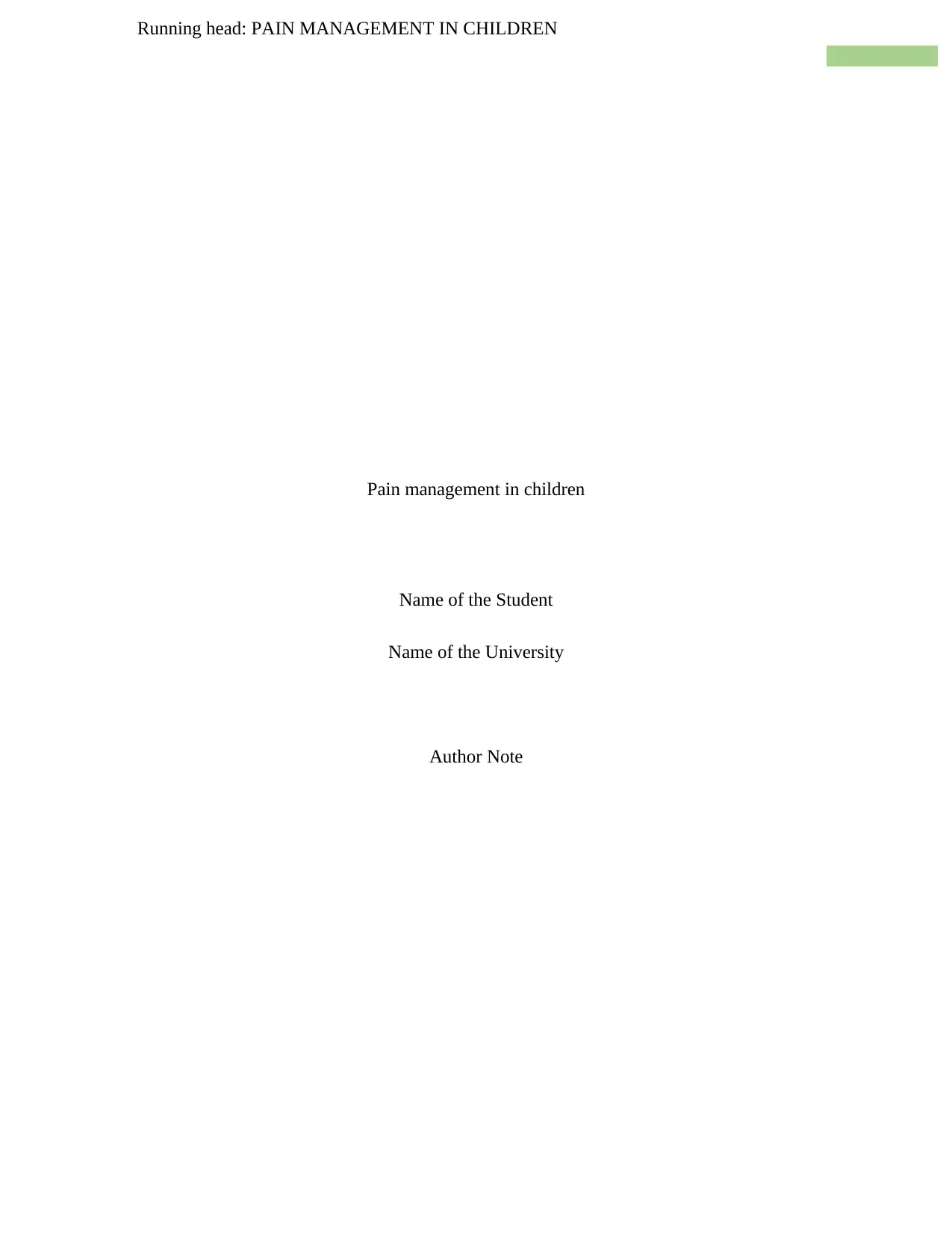
Running head: PAIN MANAGEMENT IN CHILDREN
Pain management in children
Name of the Student
Name of the University
Author Note
Pain management in children
Name of the Student
Name of the University
Author Note
Secure Best Marks with AI Grader
Need help grading? Try our AI Grader for instant feedback on your assignments.
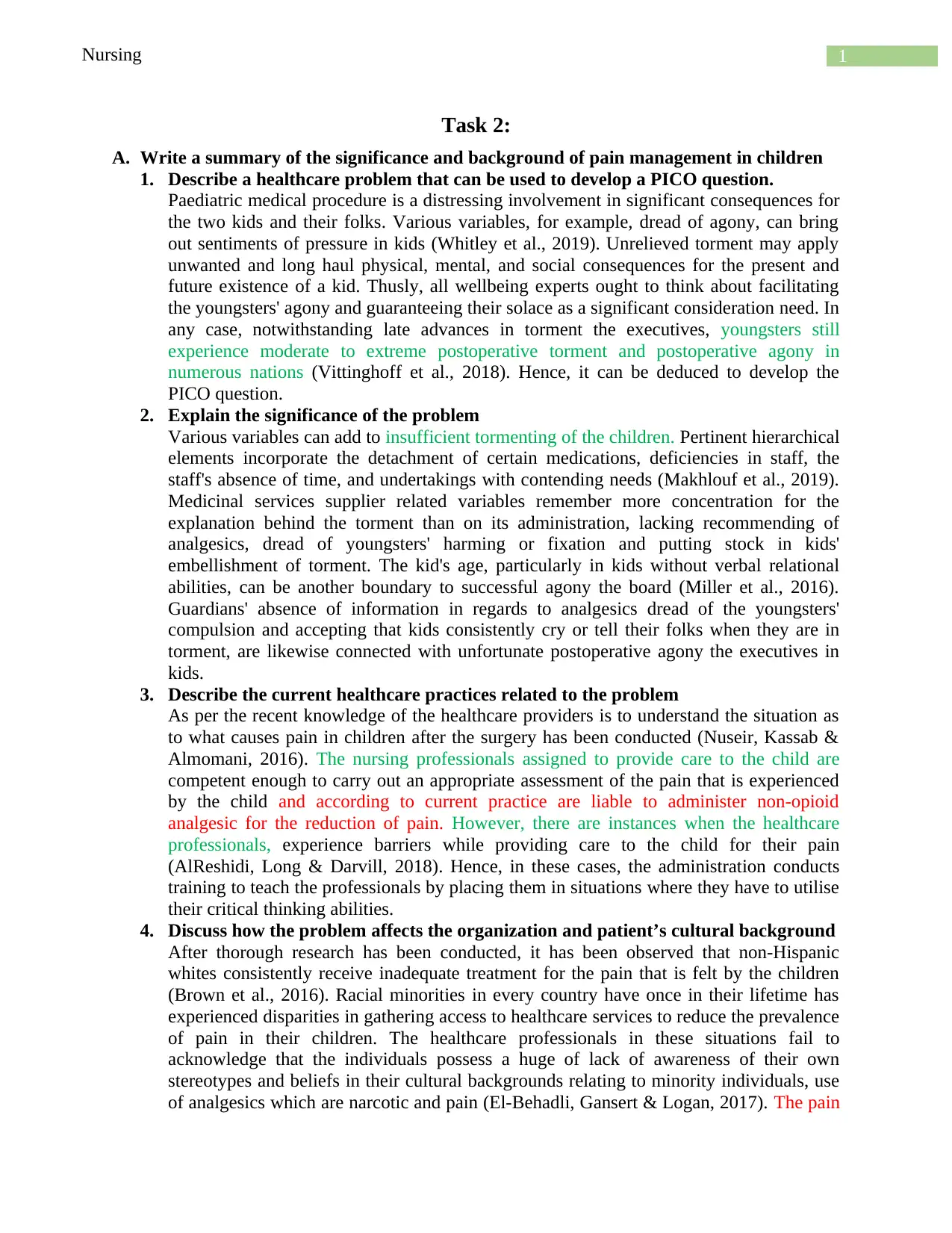
1Nursing
Task 2:
A. Write a summary of the significance and background of pain management in children
1. Describe a healthcare problem that can be used to develop a PICO question.
Paediatric medical procedure is a distressing involvement in significant consequences for
the two kids and their folks. Various variables, for example, dread of agony, can bring
out sentiments of pressure in kids (Whitley et al., 2019). Unrelieved torment may apply
unwanted and long haul physical, mental, and social consequences for the present and
future existence of a kid. Thusly, all wellbeing experts ought to think about facilitating
the youngsters' agony and guaranteeing their solace as a significant consideration need. In
any case, notwithstanding late advances in torment the executives, youngsters still
experience moderate to extreme postoperative torment and postoperative agony in
numerous nations (Vittinghoff et al., 2018). Hence, it can be deduced to develop the
PICO question.
2. Explain the significance of the problem
Various variables can add to insufficient tormenting of the children. Pertinent hierarchical
elements incorporate the detachment of certain medications, deficiencies in staff, the
staff's absence of time, and undertakings with contending needs (Makhlouf et al., 2019).
Medicinal services supplier related variables remember more concentration for the
explanation behind the torment than on its administration, lacking recommending of
analgesics, dread of youngsters' harming or fixation and putting stock in kids'
embellishment of torment. The kid's age, particularly in kids without verbal relational
abilities, can be another boundary to successful agony the board (Miller et al., 2016).
Guardians' absence of information in regards to analgesics dread of the youngsters'
compulsion and accepting that kids consistently cry or tell their folks when they are in
torment, are likewise connected with unfortunate postoperative agony the executives in
kids.
3. Describe the current healthcare practices related to the problem
As per the recent knowledge of the healthcare providers is to understand the situation as
to what causes pain in children after the surgery has been conducted (Nuseir, Kassab &
Almomani, 2016). The nursing professionals assigned to provide care to the child are
competent enough to carry out an appropriate assessment of the pain that is experienced
by the child and according to current practice are liable to administer non-opioid
analgesic for the reduction of pain. However, there are instances when the healthcare
professionals, experience barriers while providing care to the child for their pain
(AlReshidi, Long & Darvill, 2018). Hence, in these cases, the administration conducts
training to teach the professionals by placing them in situations where they have to utilise
their critical thinking abilities.
4. Discuss how the problem affects the organization and patient’s cultural background
After thorough research has been conducted, it has been observed that non-Hispanic
whites consistently receive inadequate treatment for the pain that is felt by the children
(Brown et al., 2016). Racial minorities in every country have once in their lifetime has
experienced disparities in gathering access to healthcare services to reduce the prevalence
of pain in their children. The healthcare professionals in these situations fail to
acknowledge that the individuals possess a huge of lack of awareness of their own
stereotypes and beliefs in their cultural backgrounds relating to minority individuals, use
of analgesics which are narcotic and pain (El-Behadli, Gansert & Logan, 2017). The pain
Task 2:
A. Write a summary of the significance and background of pain management in children
1. Describe a healthcare problem that can be used to develop a PICO question.
Paediatric medical procedure is a distressing involvement in significant consequences for
the two kids and their folks. Various variables, for example, dread of agony, can bring
out sentiments of pressure in kids (Whitley et al., 2019). Unrelieved torment may apply
unwanted and long haul physical, mental, and social consequences for the present and
future existence of a kid. Thusly, all wellbeing experts ought to think about facilitating
the youngsters' agony and guaranteeing their solace as a significant consideration need. In
any case, notwithstanding late advances in torment the executives, youngsters still
experience moderate to extreme postoperative torment and postoperative agony in
numerous nations (Vittinghoff et al., 2018). Hence, it can be deduced to develop the
PICO question.
2. Explain the significance of the problem
Various variables can add to insufficient tormenting of the children. Pertinent hierarchical
elements incorporate the detachment of certain medications, deficiencies in staff, the
staff's absence of time, and undertakings with contending needs (Makhlouf et al., 2019).
Medicinal services supplier related variables remember more concentration for the
explanation behind the torment than on its administration, lacking recommending of
analgesics, dread of youngsters' harming or fixation and putting stock in kids'
embellishment of torment. The kid's age, particularly in kids without verbal relational
abilities, can be another boundary to successful agony the board (Miller et al., 2016).
Guardians' absence of information in regards to analgesics dread of the youngsters'
compulsion and accepting that kids consistently cry or tell their folks when they are in
torment, are likewise connected with unfortunate postoperative agony the executives in
kids.
3. Describe the current healthcare practices related to the problem
As per the recent knowledge of the healthcare providers is to understand the situation as
to what causes pain in children after the surgery has been conducted (Nuseir, Kassab &
Almomani, 2016). The nursing professionals assigned to provide care to the child are
competent enough to carry out an appropriate assessment of the pain that is experienced
by the child and according to current practice are liable to administer non-opioid
analgesic for the reduction of pain. However, there are instances when the healthcare
professionals, experience barriers while providing care to the child for their pain
(AlReshidi, Long & Darvill, 2018). Hence, in these cases, the administration conducts
training to teach the professionals by placing them in situations where they have to utilise
their critical thinking abilities.
4. Discuss how the problem affects the organization and patient’s cultural background
After thorough research has been conducted, it has been observed that non-Hispanic
whites consistently receive inadequate treatment for the pain that is felt by the children
(Brown et al., 2016). Racial minorities in every country have once in their lifetime has
experienced disparities in gathering access to healthcare services to reduce the prevalence
of pain in their children. The healthcare professionals in these situations fail to
acknowledge that the individuals possess a huge of lack of awareness of their own
stereotypes and beliefs in their cultural backgrounds relating to minority individuals, use
of analgesics which are narcotic and pain (El-Behadli, Gansert & Logan, 2017). The pain
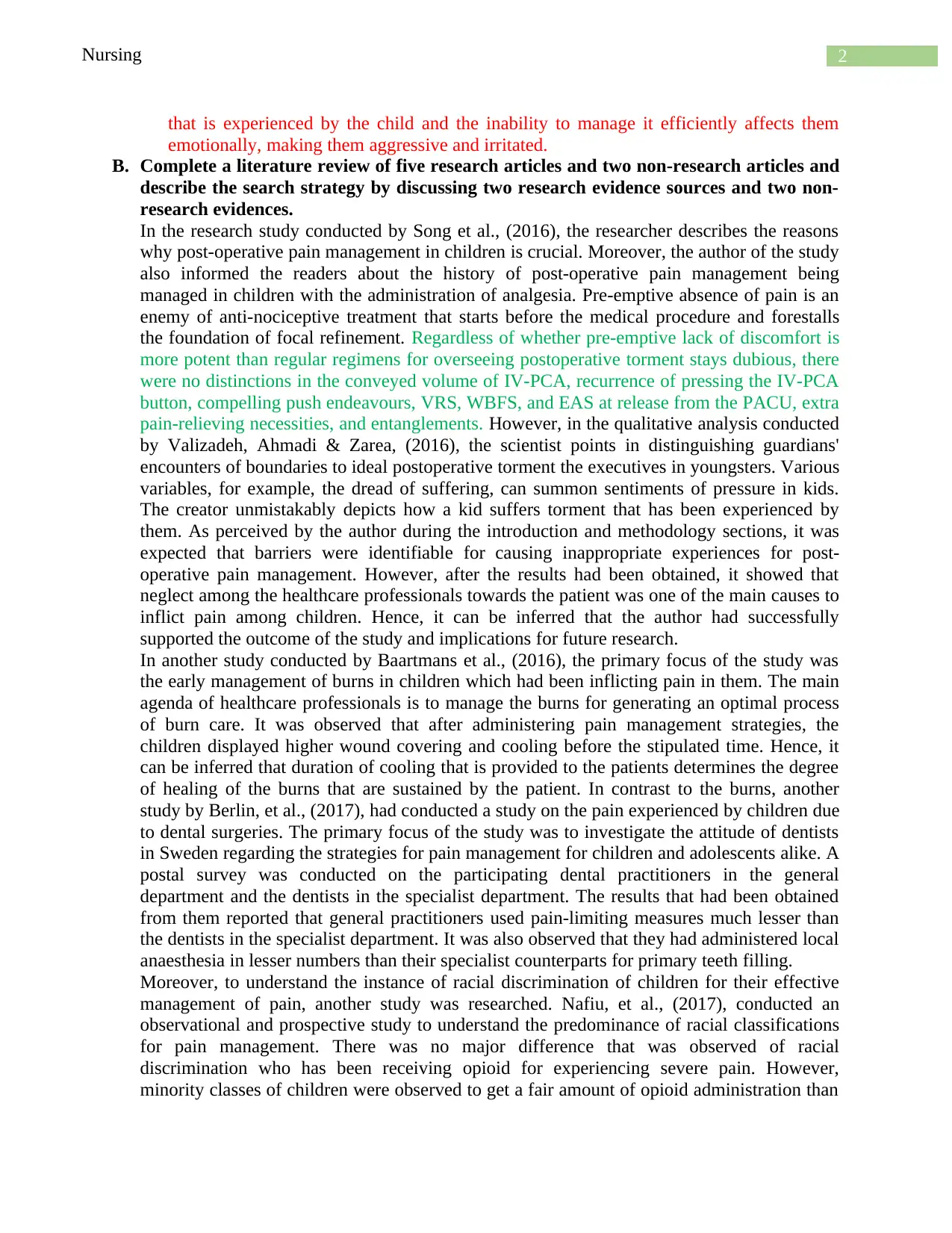
2Nursing
that is experienced by the child and the inability to manage it efficiently affects them
emotionally, making them aggressive and irritated.
B. Complete a literature review of five research articles and two non-research articles and
describe the search strategy by discussing two research evidence sources and two non-
research evidences.
In the research study conducted by Song et al., (2016), the researcher describes the reasons
why post-operative pain management in children is crucial. Moreover, the author of the study
also informed the readers about the history of post-operative pain management being
managed in children with the administration of analgesia. Pre-emptive absence of pain is an
enemy of anti-nociceptive treatment that starts before the medical procedure and forestalls
the foundation of focal refinement. Regardless of whether pre-emptive lack of discomfort is
more potent than regular regimens for overseeing postoperative torment stays dubious, there
were no distinctions in the conveyed volume of IV-PCA, recurrence of pressing the IV-PCA
button, compelling push endeavours, VRS, WBFS, and EAS at release from the PACU, extra
pain-relieving necessities, and entanglements. However, in the qualitative analysis conducted
by Valizadeh, Ahmadi & Zarea, (2016), the scientist points in distinguishing guardians'
encounters of boundaries to ideal postoperative torment the executives in youngsters. Various
variables, for example, the dread of suffering, can summon sentiments of pressure in kids.
The creator unmistakably depicts how a kid suffers torment that has been experienced by
them. As perceived by the author during the introduction and methodology sections, it was
expected that barriers were identifiable for causing inappropriate experiences for post-
operative pain management. However, after the results had been obtained, it showed that
neglect among the healthcare professionals towards the patient was one of the main causes to
inflict pain among children. Hence, it can be inferred that the author had successfully
supported the outcome of the study and implications for future research.
In another study conducted by Baartmans et al., (2016), the primary focus of the study was
the early management of burns in children which had been inflicting pain in them. The main
agenda of healthcare professionals is to manage the burns for generating an optimal process
of burn care. It was observed that after administering pain management strategies, the
children displayed higher wound covering and cooling before the stipulated time. Hence, it
can be inferred that duration of cooling that is provided to the patients determines the degree
of healing of the burns that are sustained by the patient. In contrast to the burns, another
study by Berlin, et al., (2017), had conducted a study on the pain experienced by children due
to dental surgeries. The primary focus of the study was to investigate the attitude of dentists
in Sweden regarding the strategies for pain management for children and adolescents alike. A
postal survey was conducted on the participating dental practitioners in the general
department and the dentists in the specialist department. The results that had been obtained
from them reported that general practitioners used pain-limiting measures much lesser than
the dentists in the specialist department. It was also observed that they had administered local
anaesthesia in lesser numbers than their specialist counterparts for primary teeth filling.
Moreover, to understand the instance of racial discrimination of children for their effective
management of pain, another study was researched. Nafiu, et al., (2017), conducted an
observational and prospective study to understand the predominance of racial classifications
for pain management. There was no major difference that was observed of racial
discrimination who has been receiving opioid for experiencing severe pain. However,
minority classes of children were observed to get a fair amount of opioid administration than
that is experienced by the child and the inability to manage it efficiently affects them
emotionally, making them aggressive and irritated.
B. Complete a literature review of five research articles and two non-research articles and
describe the search strategy by discussing two research evidence sources and two non-
research evidences.
In the research study conducted by Song et al., (2016), the researcher describes the reasons
why post-operative pain management in children is crucial. Moreover, the author of the study
also informed the readers about the history of post-operative pain management being
managed in children with the administration of analgesia. Pre-emptive absence of pain is an
enemy of anti-nociceptive treatment that starts before the medical procedure and forestalls
the foundation of focal refinement. Regardless of whether pre-emptive lack of discomfort is
more potent than regular regimens for overseeing postoperative torment stays dubious, there
were no distinctions in the conveyed volume of IV-PCA, recurrence of pressing the IV-PCA
button, compelling push endeavours, VRS, WBFS, and EAS at release from the PACU, extra
pain-relieving necessities, and entanglements. However, in the qualitative analysis conducted
by Valizadeh, Ahmadi & Zarea, (2016), the scientist points in distinguishing guardians'
encounters of boundaries to ideal postoperative torment the executives in youngsters. Various
variables, for example, the dread of suffering, can summon sentiments of pressure in kids.
The creator unmistakably depicts how a kid suffers torment that has been experienced by
them. As perceived by the author during the introduction and methodology sections, it was
expected that barriers were identifiable for causing inappropriate experiences for post-
operative pain management. However, after the results had been obtained, it showed that
neglect among the healthcare professionals towards the patient was one of the main causes to
inflict pain among children. Hence, it can be inferred that the author had successfully
supported the outcome of the study and implications for future research.
In another study conducted by Baartmans et al., (2016), the primary focus of the study was
the early management of burns in children which had been inflicting pain in them. The main
agenda of healthcare professionals is to manage the burns for generating an optimal process
of burn care. It was observed that after administering pain management strategies, the
children displayed higher wound covering and cooling before the stipulated time. Hence, it
can be inferred that duration of cooling that is provided to the patients determines the degree
of healing of the burns that are sustained by the patient. In contrast to the burns, another
study by Berlin, et al., (2017), had conducted a study on the pain experienced by children due
to dental surgeries. The primary focus of the study was to investigate the attitude of dentists
in Sweden regarding the strategies for pain management for children and adolescents alike. A
postal survey was conducted on the participating dental practitioners in the general
department and the dentists in the specialist department. The results that had been obtained
from them reported that general practitioners used pain-limiting measures much lesser than
the dentists in the specialist department. It was also observed that they had administered local
anaesthesia in lesser numbers than their specialist counterparts for primary teeth filling.
Moreover, to understand the instance of racial discrimination of children for their effective
management of pain, another study was researched. Nafiu, et al., (2017), conducted an
observational and prospective study to understand the predominance of racial classifications
for pain management. There was no major difference that was observed of racial
discrimination who has been receiving opioid for experiencing severe pain. However,
minority classes of children were observed to get a fair amount of opioid administration than
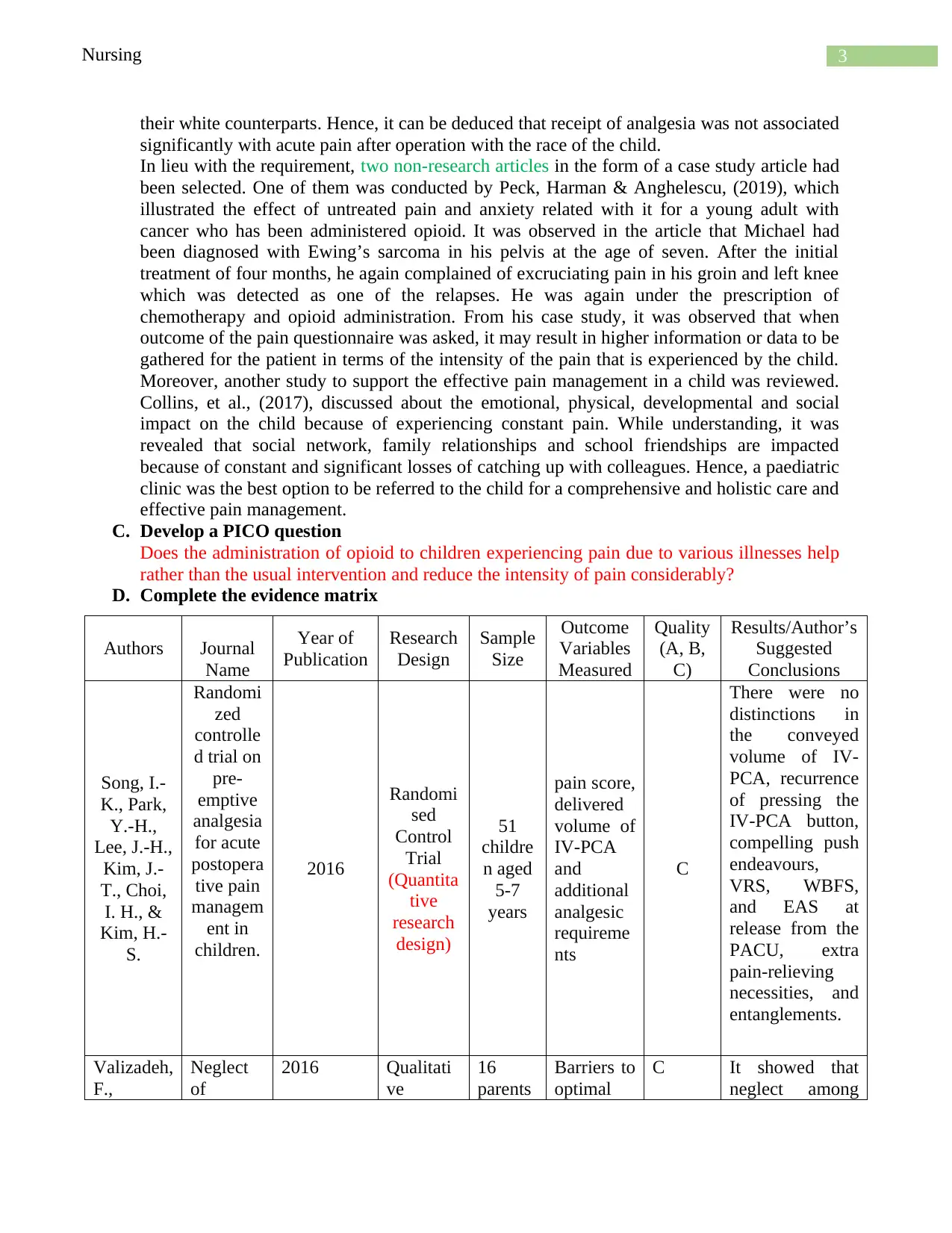
3Nursing
their white counterparts. Hence, it can be deduced that receipt of analgesia was not associated
significantly with acute pain after operation with the race of the child.
In lieu with the requirement, two non-research articles in the form of a case study article had
been selected. One of them was conducted by Peck, Harman & Anghelescu, (2019), which
illustrated the effect of untreated pain and anxiety related with it for a young adult with
cancer who has been administered opioid. It was observed in the article that Michael had
been diagnosed with Ewing’s sarcoma in his pelvis at the age of seven. After the initial
treatment of four months, he again complained of excruciating pain in his groin and left knee
which was detected as one of the relapses. He was again under the prescription of
chemotherapy and opioid administration. From his case study, it was observed that when
outcome of the pain questionnaire was asked, it may result in higher information or data to be
gathered for the patient in terms of the intensity of the pain that is experienced by the child.
Moreover, another study to support the effective pain management in a child was reviewed.
Collins, et al., (2017), discussed about the emotional, physical, developmental and social
impact on the child because of experiencing constant pain. While understanding, it was
revealed that social network, family relationships and school friendships are impacted
because of constant and significant losses of catching up with colleagues. Hence, a paediatric
clinic was the best option to be referred to the child for a comprehensive and holistic care and
effective pain management.
C. Develop a PICO question
Does the administration of opioid to children experiencing pain due to various illnesses help
rather than the usual intervention and reduce the intensity of pain considerably?
D. Complete the evidence matrix
Authors Journal
Name
Year of
Publication
Research
Design
Sample
Size
Outcome
Variables
Measured
Quality
(A, B,
C)
Results/Author’s
Suggested
Conclusions
Song, I.-
K., Park,
Y.-H.,
Lee, J.-H.,
Kim, J.-
T., Choi,
I. H., &
Kim, H.-
S.
Randomi
zed
controlle
d trial on
pre-
emptive
analgesia
for acute
postopera
tive pain
managem
ent in
children.
2016
Randomi
sed
Control
Trial
(Quantita
tive
research
design)
51
childre
n aged
5-7
years
pain score,
delivered
volume of
IV-PCA
and
additional
analgesic
requireme
nts
C
There were no
distinctions in
the conveyed
volume of IV-
PCA, recurrence
of pressing the
IV-PCA button,
compelling push
endeavours,
VRS, WBFS,
and EAS at
release from the
PACU, extra
pain-relieving
necessities, and
entanglements.
Valizadeh,
F.,
Neglect
of
2016 Qualitati
ve
16
parents
Barriers to
optimal
C It showed that
neglect among
their white counterparts. Hence, it can be deduced that receipt of analgesia was not associated
significantly with acute pain after operation with the race of the child.
In lieu with the requirement, two non-research articles in the form of a case study article had
been selected. One of them was conducted by Peck, Harman & Anghelescu, (2019), which
illustrated the effect of untreated pain and anxiety related with it for a young adult with
cancer who has been administered opioid. It was observed in the article that Michael had
been diagnosed with Ewing’s sarcoma in his pelvis at the age of seven. After the initial
treatment of four months, he again complained of excruciating pain in his groin and left knee
which was detected as one of the relapses. He was again under the prescription of
chemotherapy and opioid administration. From his case study, it was observed that when
outcome of the pain questionnaire was asked, it may result in higher information or data to be
gathered for the patient in terms of the intensity of the pain that is experienced by the child.
Moreover, another study to support the effective pain management in a child was reviewed.
Collins, et al., (2017), discussed about the emotional, physical, developmental and social
impact on the child because of experiencing constant pain. While understanding, it was
revealed that social network, family relationships and school friendships are impacted
because of constant and significant losses of catching up with colleagues. Hence, a paediatric
clinic was the best option to be referred to the child for a comprehensive and holistic care and
effective pain management.
C. Develop a PICO question
Does the administration of opioid to children experiencing pain due to various illnesses help
rather than the usual intervention and reduce the intensity of pain considerably?
D. Complete the evidence matrix
Authors Journal
Name
Year of
Publication
Research
Design
Sample
Size
Outcome
Variables
Measured
Quality
(A, B,
C)
Results/Author’s
Suggested
Conclusions
Song, I.-
K., Park,
Y.-H.,
Lee, J.-H.,
Kim, J.-
T., Choi,
I. H., &
Kim, H.-
S.
Randomi
zed
controlle
d trial on
pre-
emptive
analgesia
for acute
postopera
tive pain
managem
ent in
children.
2016
Randomi
sed
Control
Trial
(Quantita
tive
research
design)
51
childre
n aged
5-7
years
pain score,
delivered
volume of
IV-PCA
and
additional
analgesic
requireme
nts
C
There were no
distinctions in
the conveyed
volume of IV-
PCA, recurrence
of pressing the
IV-PCA button,
compelling push
endeavours,
VRS, WBFS,
and EAS at
release from the
PACU, extra
pain-relieving
necessities, and
entanglements.
Valizadeh,
F.,
Neglect
of
2016 Qualitati
ve
16
parents
Barriers to
optimal
C It showed that
neglect among
Secure Best Marks with AI Grader
Need help grading? Try our AI Grader for instant feedback on your assignments.
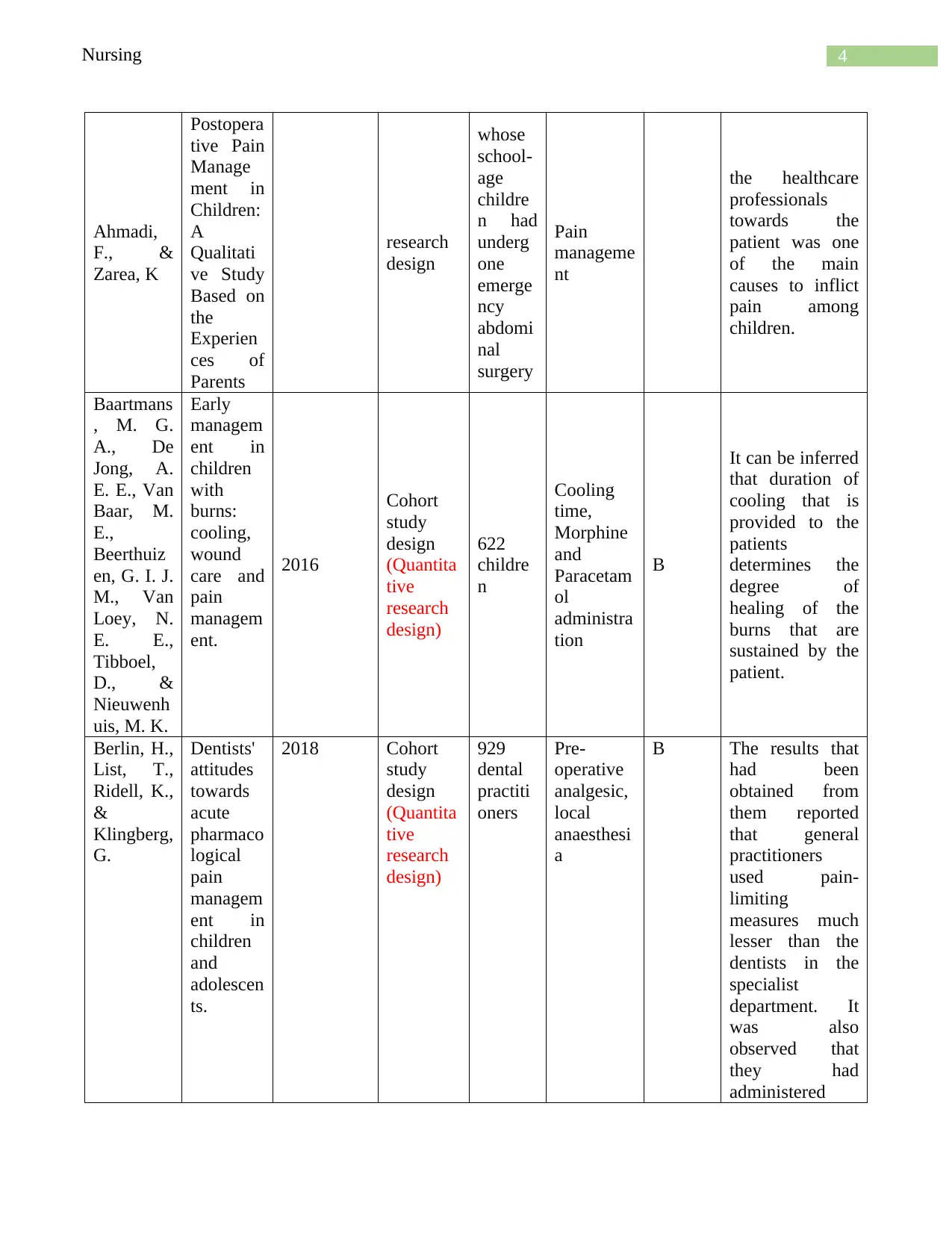
4Nursing
Ahmadi,
F., &
Zarea, K
Postopera
tive Pain
Manage
ment in
Children:
A
Qualitati
ve Study
Based on
the
Experien
ces of
Parents
research
design
whose
school-
age
childre
n had
underg
one
emerge
ncy
abdomi
nal
surgery
Pain
manageme
nt
the healthcare
professionals
towards the
patient was one
of the main
causes to inflict
pain among
children.
Baartmans
, M. G.
A., De
Jong, A.
E. E., Van
Baar, M.
E.,
Beerthuiz
en, G. I. J.
M., Van
Loey, N.
E. E.,
Tibboel,
D., &
Nieuwenh
uis, M. K.
Early
managem
ent in
children
with
burns:
cooling,
wound
care and
pain
managem
ent.
2016
Cohort
study
design
(Quantita
tive
research
design)
622
childre
n
Cooling
time,
Morphine
and
Paracetam
ol
administra
tion
B
It can be inferred
that duration of
cooling that is
provided to the
patients
determines the
degree of
healing of the
burns that are
sustained by the
patient.
Berlin, H.,
List, T.,
Ridell, K.,
&
Klingberg,
G.
Dentists'
attitudes
towards
acute
pharmaco
logical
pain
managem
ent in
children
and
adolescen
ts.
2018 Cohort
study
design
(Quantita
tive
research
design)
929
dental
practiti
oners
Pre-
operative
analgesic,
local
anaesthesi
a
B The results that
had been
obtained from
them reported
that general
practitioners
used pain-
limiting
measures much
lesser than the
dentists in the
specialist
department. It
was also
observed that
they had
administered
Ahmadi,
F., &
Zarea, K
Postopera
tive Pain
Manage
ment in
Children:
A
Qualitati
ve Study
Based on
the
Experien
ces of
Parents
research
design
whose
school-
age
childre
n had
underg
one
emerge
ncy
abdomi
nal
surgery
Pain
manageme
nt
the healthcare
professionals
towards the
patient was one
of the main
causes to inflict
pain among
children.
Baartmans
, M. G.
A., De
Jong, A.
E. E., Van
Baar, M.
E.,
Beerthuiz
en, G. I. J.
M., Van
Loey, N.
E. E.,
Tibboel,
D., &
Nieuwenh
uis, M. K.
Early
managem
ent in
children
with
burns:
cooling,
wound
care and
pain
managem
ent.
2016
Cohort
study
design
(Quantita
tive
research
design)
622
childre
n
Cooling
time,
Morphine
and
Paracetam
ol
administra
tion
B
It can be inferred
that duration of
cooling that is
provided to the
patients
determines the
degree of
healing of the
burns that are
sustained by the
patient.
Berlin, H.,
List, T.,
Ridell, K.,
&
Klingberg,
G.
Dentists'
attitudes
towards
acute
pharmaco
logical
pain
managem
ent in
children
and
adolescen
ts.
2018 Cohort
study
design
(Quantita
tive
research
design)
929
dental
practiti
oners
Pre-
operative
analgesic,
local
anaesthesi
a
B The results that
had been
obtained from
them reported
that general
practitioners
used pain-
limiting
measures much
lesser than the
dentists in the
specialist
department. It
was also
observed that
they had
administered
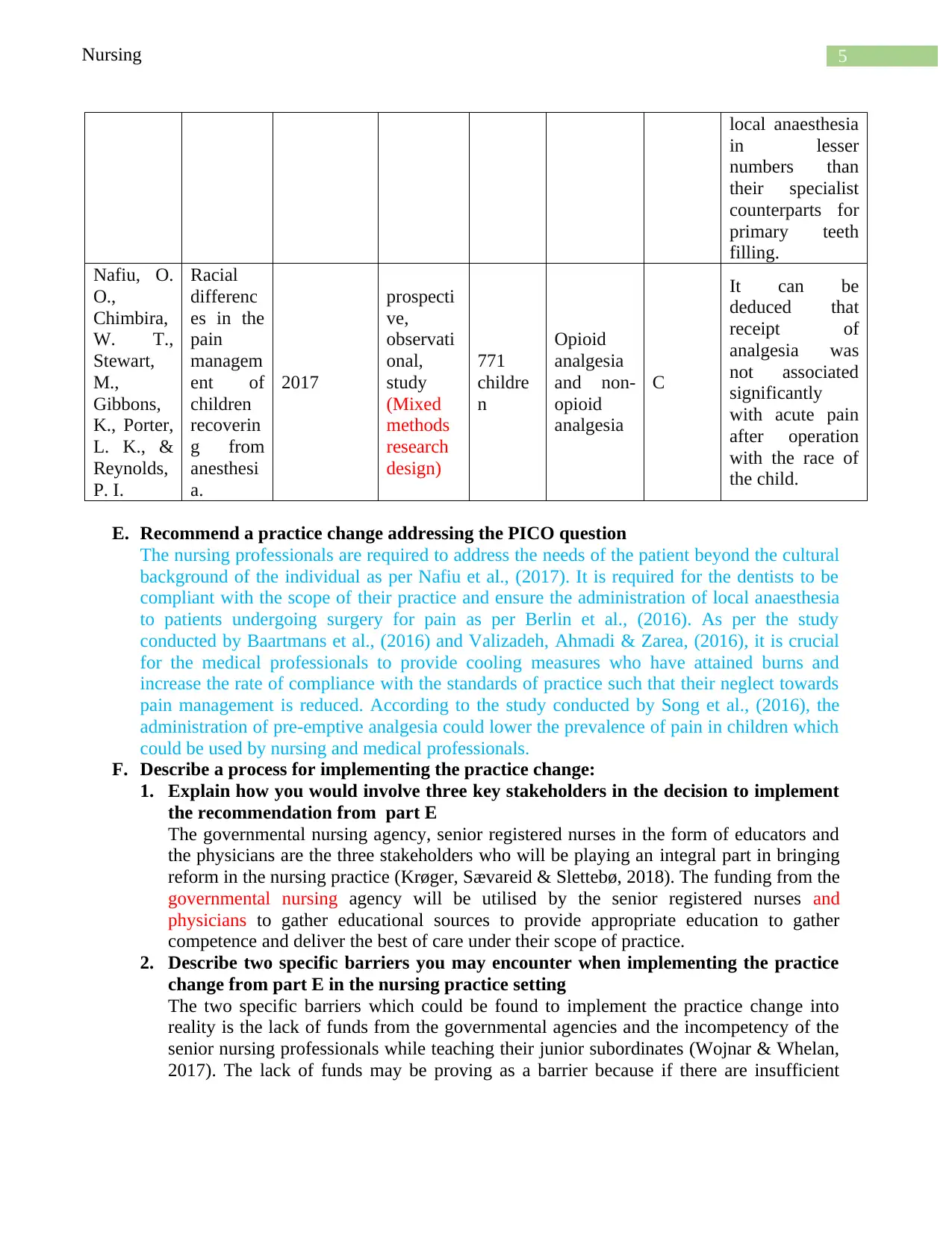
5Nursing
local anaesthesia
in lesser
numbers than
their specialist
counterparts for
primary teeth
filling.
Nafiu, O.
O.,
Chimbira,
W. T.,
Stewart,
M.,
Gibbons,
K., Porter,
L. K., &
Reynolds,
P. I.
Racial
differenc
es in the
pain
managem
ent of
children
recoverin
g from
anesthesi
a.
2017
prospecti
ve,
observati
onal,
study
(Mixed
methods
research
design)
771
childre
n
Opioid
analgesia
and non-
opioid
analgesia
C
It can be
deduced that
receipt of
analgesia was
not associated
significantly
with acute pain
after operation
with the race of
the child.
E. Recommend a practice change addressing the PICO question
The nursing professionals are required to address the needs of the patient beyond the cultural
background of the individual as per Nafiu et al., (2017). It is required for the dentists to be
compliant with the scope of their practice and ensure the administration of local anaesthesia
to patients undergoing surgery for pain as per Berlin et al., (2016). As per the study
conducted by Baartmans et al., (2016) and Valizadeh, Ahmadi & Zarea, (2016), it is crucial
for the medical professionals to provide cooling measures who have attained burns and
increase the rate of compliance with the standards of practice such that their neglect towards
pain management is reduced. According to the study conducted by Song et al., (2016), the
administration of pre-emptive analgesia could lower the prevalence of pain in children which
could be used by nursing and medical professionals.
F. Describe a process for implementing the practice change:
1. Explain how you would involve three key stakeholders in the decision to implement
the recommendation from part E
The governmental nursing agency, senior registered nurses in the form of educators and
the physicians are the three stakeholders who will be playing an integral part in bringing
reform in the nursing practice (Krøger, Sævareid & Slettebø, 2018). The funding from the
governmental nursing agency will be utilised by the senior registered nurses and
physicians to gather educational sources to provide appropriate education to gather
competence and deliver the best of care under their scope of practice.
2. Describe two specific barriers you may encounter when implementing the practice
change from part E in the nursing practice setting
The two specific barriers which could be found to implement the practice change into
reality is the lack of funds from the governmental agencies and the incompetency of the
senior nursing professionals while teaching their junior subordinates (Wojnar & Whelan,
2017). The lack of funds may be proving as a barrier because if there are insufficient
local anaesthesia
in lesser
numbers than
their specialist
counterparts for
primary teeth
filling.
Nafiu, O.
O.,
Chimbira,
W. T.,
Stewart,
M.,
Gibbons,
K., Porter,
L. K., &
Reynolds,
P. I.
Racial
differenc
es in the
pain
managem
ent of
children
recoverin
g from
anesthesi
a.
2017
prospecti
ve,
observati
onal,
study
(Mixed
methods
research
design)
771
childre
n
Opioid
analgesia
and non-
opioid
analgesia
C
It can be
deduced that
receipt of
analgesia was
not associated
significantly
with acute pain
after operation
with the race of
the child.
E. Recommend a practice change addressing the PICO question
The nursing professionals are required to address the needs of the patient beyond the cultural
background of the individual as per Nafiu et al., (2017). It is required for the dentists to be
compliant with the scope of their practice and ensure the administration of local anaesthesia
to patients undergoing surgery for pain as per Berlin et al., (2016). As per the study
conducted by Baartmans et al., (2016) and Valizadeh, Ahmadi & Zarea, (2016), it is crucial
for the medical professionals to provide cooling measures who have attained burns and
increase the rate of compliance with the standards of practice such that their neglect towards
pain management is reduced. According to the study conducted by Song et al., (2016), the
administration of pre-emptive analgesia could lower the prevalence of pain in children which
could be used by nursing and medical professionals.
F. Describe a process for implementing the practice change:
1. Explain how you would involve three key stakeholders in the decision to implement
the recommendation from part E
The governmental nursing agency, senior registered nurses in the form of educators and
the physicians are the three stakeholders who will be playing an integral part in bringing
reform in the nursing practice (Krøger, Sævareid & Slettebø, 2018). The funding from the
governmental nursing agency will be utilised by the senior registered nurses and
physicians to gather educational sources to provide appropriate education to gather
competence and deliver the best of care under their scope of practice.
2. Describe two specific barriers you may encounter when implementing the practice
change from part E in the nursing practice setting
The two specific barriers which could be found to implement the practice change into
reality is the lack of funds from the governmental agencies and the incompetency of the
senior nursing professionals while teaching their junior subordinates (Wojnar & Whelan,
2017). The lack of funds may be proving as a barrier because if there are insufficient
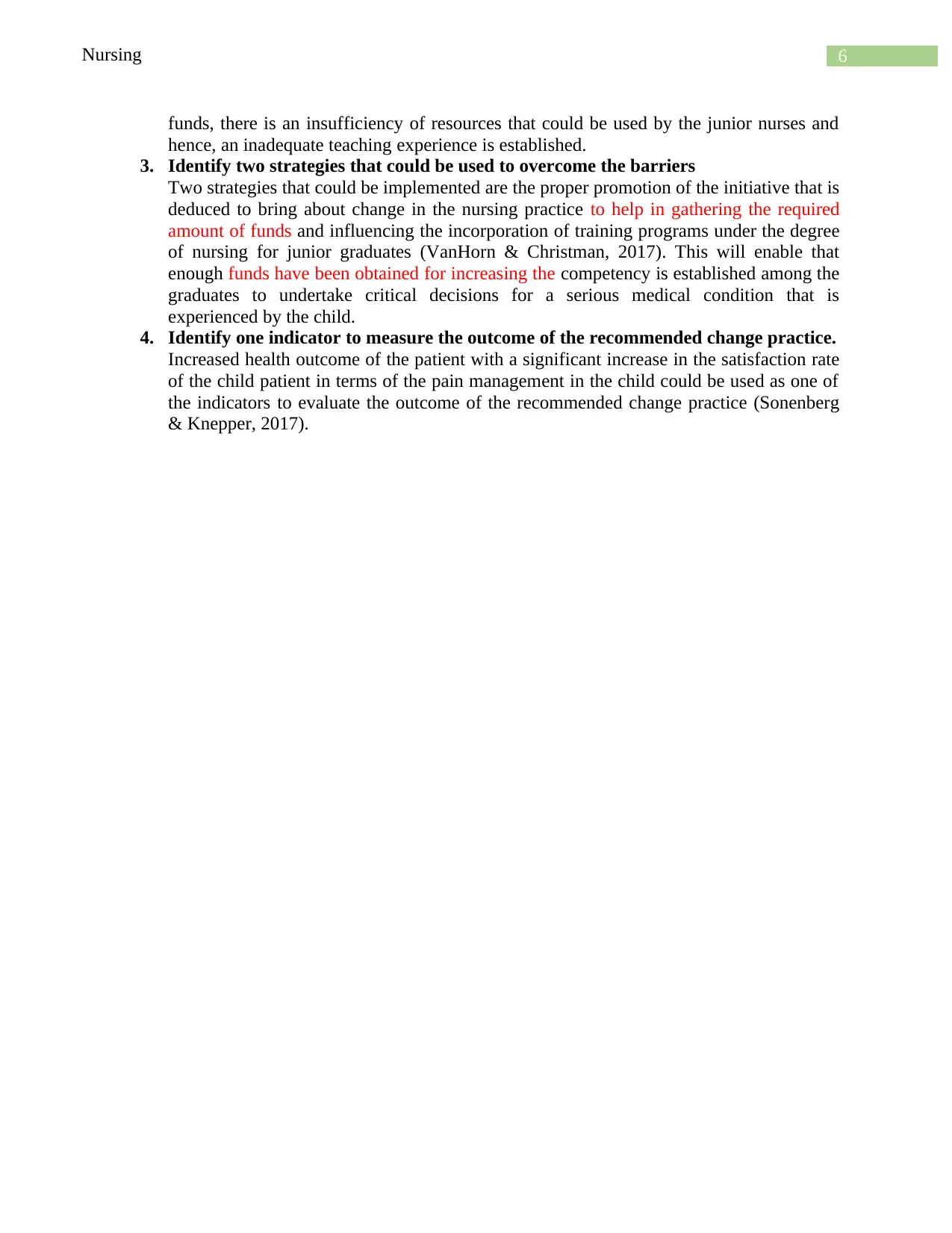
6Nursing
funds, there is an insufficiency of resources that could be used by the junior nurses and
hence, an inadequate teaching experience is established.
3. Identify two strategies that could be used to overcome the barriers
Two strategies that could be implemented are the proper promotion of the initiative that is
deduced to bring about change in the nursing practice to help in gathering the required
amount of funds and influencing the incorporation of training programs under the degree
of nursing for junior graduates (VanHorn & Christman, 2017). This will enable that
enough funds have been obtained for increasing the competency is established among the
graduates to undertake critical decisions for a serious medical condition that is
experienced by the child.
4. Identify one indicator to measure the outcome of the recommended change practice.
Increased health outcome of the patient with a significant increase in the satisfaction rate
of the child patient in terms of the pain management in the child could be used as one of
the indicators to evaluate the outcome of the recommended change practice (Sonenberg
& Knepper, 2017).
funds, there is an insufficiency of resources that could be used by the junior nurses and
hence, an inadequate teaching experience is established.
3. Identify two strategies that could be used to overcome the barriers
Two strategies that could be implemented are the proper promotion of the initiative that is
deduced to bring about change in the nursing practice to help in gathering the required
amount of funds and influencing the incorporation of training programs under the degree
of nursing for junior graduates (VanHorn & Christman, 2017). This will enable that
enough funds have been obtained for increasing the competency is established among the
graduates to undertake critical decisions for a serious medical condition that is
experienced by the child.
4. Identify one indicator to measure the outcome of the recommended change practice.
Increased health outcome of the patient with a significant increase in the satisfaction rate
of the child patient in terms of the pain management in the child could be used as one of
the indicators to evaluate the outcome of the recommended change practice (Sonenberg
& Knepper, 2017).
Paraphrase This Document
Need a fresh take? Get an instant paraphrase of this document with our AI Paraphraser
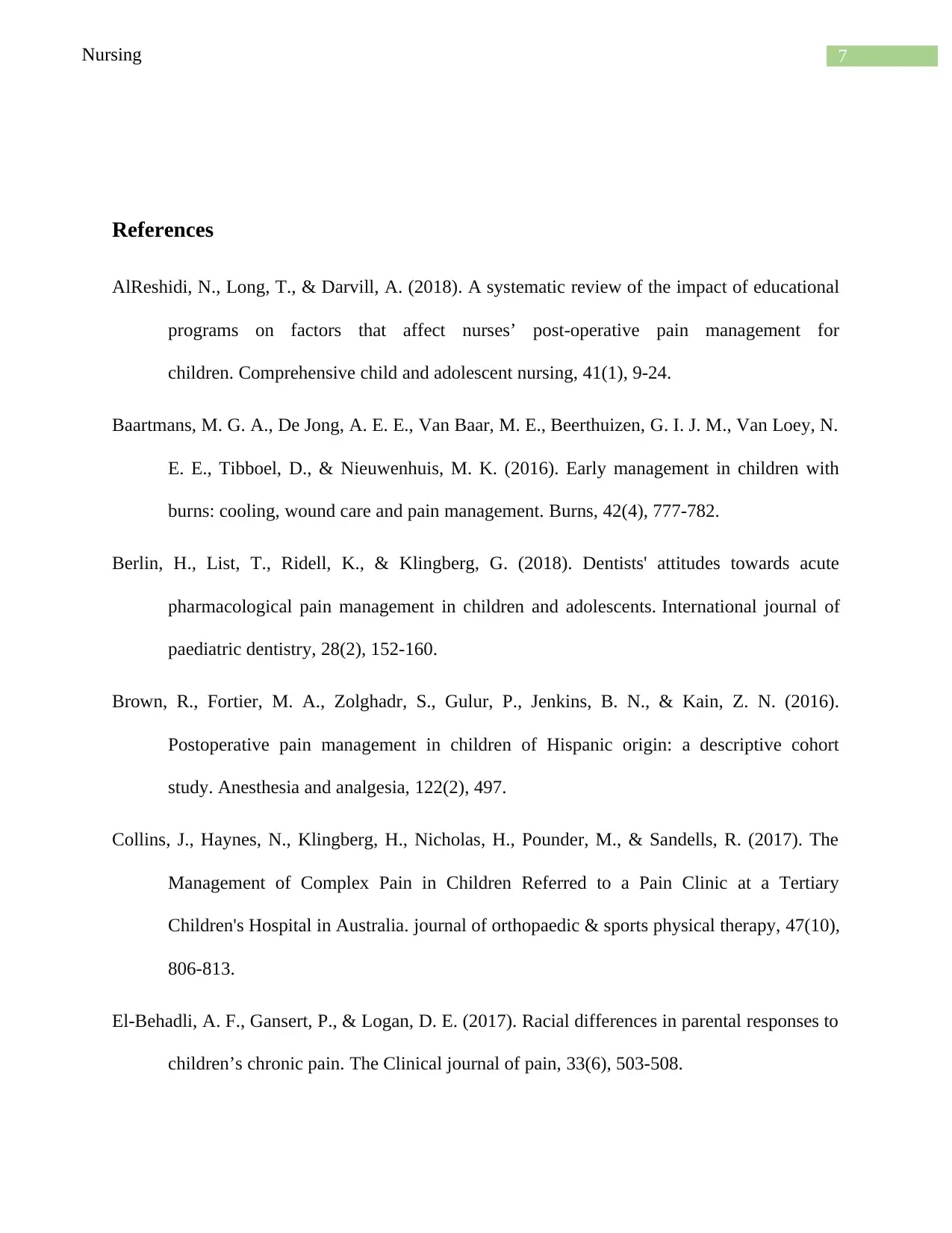
7Nursing
References
AlReshidi, N., Long, T., & Darvill, A. (2018). A systematic review of the impact of educational
programs on factors that affect nurses’ post-operative pain management for
children. Comprehensive child and adolescent nursing, 41(1), 9-24.
Baartmans, M. G. A., De Jong, A. E. E., Van Baar, M. E., Beerthuizen, G. I. J. M., Van Loey, N.
E. E., Tibboel, D., & Nieuwenhuis, M. K. (2016). Early management in children with
burns: cooling, wound care and pain management. Burns, 42(4), 777-782.
Berlin, H., List, T., Ridell, K., & Klingberg, G. (2018). Dentists' attitudes towards acute
pharmacological pain management in children and adolescents. International journal of
paediatric dentistry, 28(2), 152-160.
Brown, R., Fortier, M. A., Zolghadr, S., Gulur, P., Jenkins, B. N., & Kain, Z. N. (2016).
Postoperative pain management in children of Hispanic origin: a descriptive cohort
study. Anesthesia and analgesia, 122(2), 497.
Collins, J., Haynes, N., Klingberg, H., Nicholas, H., Pounder, M., & Sandells, R. (2017). The
Management of Complex Pain in Children Referred to a Pain Clinic at a Tertiary
Children's Hospital in Australia. journal of orthopaedic & sports physical therapy, 47(10),
806-813.
El-Behadli, A. F., Gansert, P., & Logan, D. E. (2017). Racial differences in parental responses to
children’s chronic pain. The Clinical journal of pain, 33(6), 503-508.
References
AlReshidi, N., Long, T., & Darvill, A. (2018). A systematic review of the impact of educational
programs on factors that affect nurses’ post-operative pain management for
children. Comprehensive child and adolescent nursing, 41(1), 9-24.
Baartmans, M. G. A., De Jong, A. E. E., Van Baar, M. E., Beerthuizen, G. I. J. M., Van Loey, N.
E. E., Tibboel, D., & Nieuwenhuis, M. K. (2016). Early management in children with
burns: cooling, wound care and pain management. Burns, 42(4), 777-782.
Berlin, H., List, T., Ridell, K., & Klingberg, G. (2018). Dentists' attitudes towards acute
pharmacological pain management in children and adolescents. International journal of
paediatric dentistry, 28(2), 152-160.
Brown, R., Fortier, M. A., Zolghadr, S., Gulur, P., Jenkins, B. N., & Kain, Z. N. (2016).
Postoperative pain management in children of Hispanic origin: a descriptive cohort
study. Anesthesia and analgesia, 122(2), 497.
Collins, J., Haynes, N., Klingberg, H., Nicholas, H., Pounder, M., & Sandells, R. (2017). The
Management of Complex Pain in Children Referred to a Pain Clinic at a Tertiary
Children's Hospital in Australia. journal of orthopaedic & sports physical therapy, 47(10),
806-813.
El-Behadli, A. F., Gansert, P., & Logan, D. E. (2017). Racial differences in parental responses to
children’s chronic pain. The Clinical journal of pain, 33(6), 503-508.
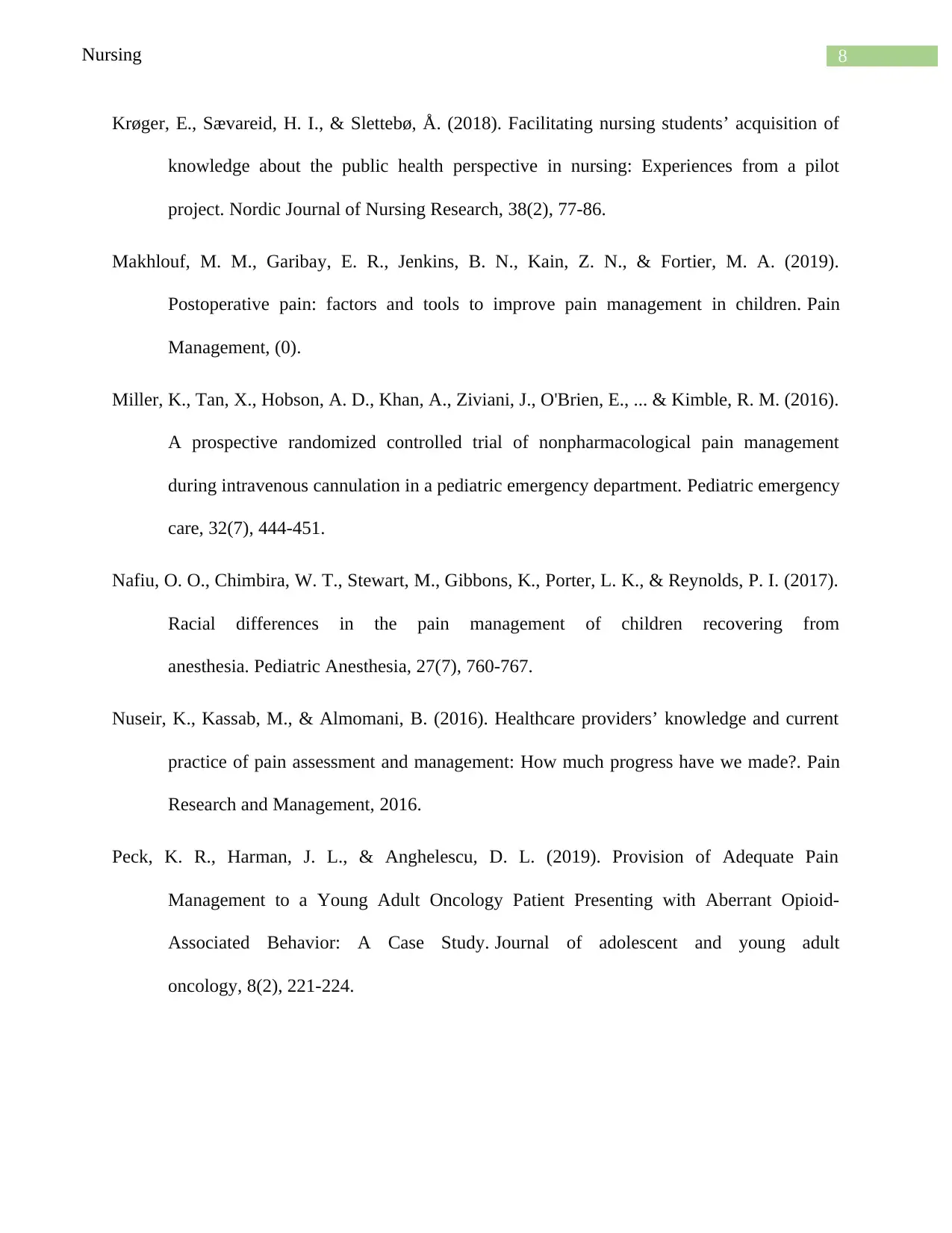
8Nursing
Krøger, E., Sævareid, H. I., & Slettebø, Å. (2018). Facilitating nursing students’ acquisition of
knowledge about the public health perspective in nursing: Experiences from a pilot
project. Nordic Journal of Nursing Research, 38(2), 77-86.
Makhlouf, M. M., Garibay, E. R., Jenkins, B. N., Kain, Z. N., & Fortier, M. A. (2019).
Postoperative pain: factors and tools to improve pain management in children. Pain
Management, (0).
Miller, K., Tan, X., Hobson, A. D., Khan, A., Ziviani, J., O'Brien, E., ... & Kimble, R. M. (2016).
A prospective randomized controlled trial of nonpharmacological pain management
during intravenous cannulation in a pediatric emergency department. Pediatric emergency
care, 32(7), 444-451.
Nafiu, O. O., Chimbira, W. T., Stewart, M., Gibbons, K., Porter, L. K., & Reynolds, P. I. (2017).
Racial differences in the pain management of children recovering from
anesthesia. Pediatric Anesthesia, 27(7), 760-767.
Nuseir, K., Kassab, M., & Almomani, B. (2016). Healthcare providers’ knowledge and current
practice of pain assessment and management: How much progress have we made?. Pain
Research and Management, 2016.
Peck, K. R., Harman, J. L., & Anghelescu, D. L. (2019). Provision of Adequate Pain
Management to a Young Adult Oncology Patient Presenting with Aberrant Opioid-
Associated Behavior: A Case Study. Journal of adolescent and young adult
oncology, 8(2), 221-224.
Krøger, E., Sævareid, H. I., & Slettebø, Å. (2018). Facilitating nursing students’ acquisition of
knowledge about the public health perspective in nursing: Experiences from a pilot
project. Nordic Journal of Nursing Research, 38(2), 77-86.
Makhlouf, M. M., Garibay, E. R., Jenkins, B. N., Kain, Z. N., & Fortier, M. A. (2019).
Postoperative pain: factors and tools to improve pain management in children. Pain
Management, (0).
Miller, K., Tan, X., Hobson, A. D., Khan, A., Ziviani, J., O'Brien, E., ... & Kimble, R. M. (2016).
A prospective randomized controlled trial of nonpharmacological pain management
during intravenous cannulation in a pediatric emergency department. Pediatric emergency
care, 32(7), 444-451.
Nafiu, O. O., Chimbira, W. T., Stewart, M., Gibbons, K., Porter, L. K., & Reynolds, P. I. (2017).
Racial differences in the pain management of children recovering from
anesthesia. Pediatric Anesthesia, 27(7), 760-767.
Nuseir, K., Kassab, M., & Almomani, B. (2016). Healthcare providers’ knowledge and current
practice of pain assessment and management: How much progress have we made?. Pain
Research and Management, 2016.
Peck, K. R., Harman, J. L., & Anghelescu, D. L. (2019). Provision of Adequate Pain
Management to a Young Adult Oncology Patient Presenting with Aberrant Opioid-
Associated Behavior: A Case Study. Journal of adolescent and young adult
oncology, 8(2), 221-224.
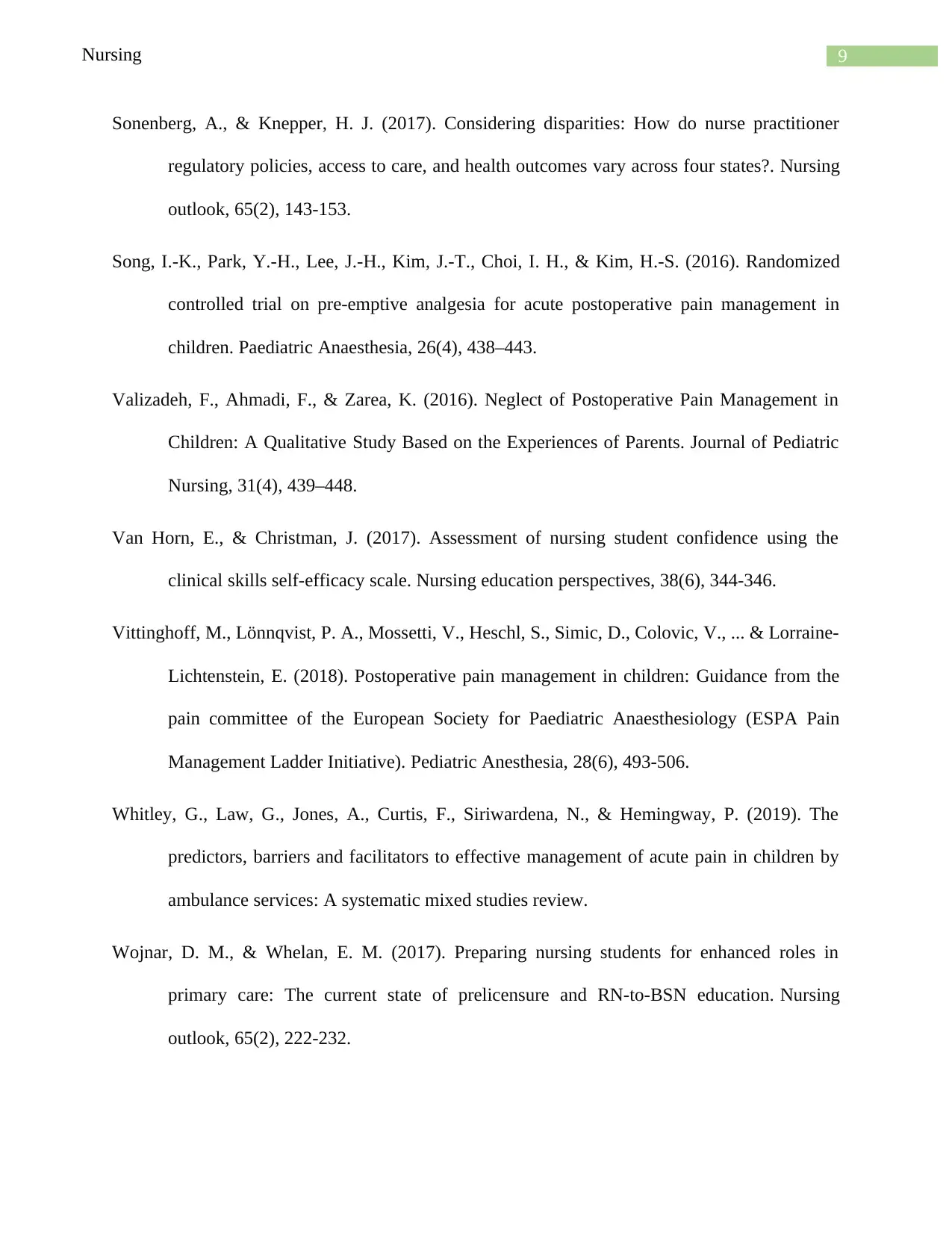
9Nursing
Sonenberg, A., & Knepper, H. J. (2017). Considering disparities: How do nurse practitioner
regulatory policies, access to care, and health outcomes vary across four states?. Nursing
outlook, 65(2), 143-153.
Song, I.-K., Park, Y.-H., Lee, J.-H., Kim, J.-T., Choi, I. H., & Kim, H.-S. (2016). Randomized
controlled trial on pre-emptive analgesia for acute postoperative pain management in
children. Paediatric Anaesthesia, 26(4), 438–443.
Valizadeh, F., Ahmadi, F., & Zarea, K. (2016). Neglect of Postoperative Pain Management in
Children: A Qualitative Study Based on the Experiences of Parents. Journal of Pediatric
Nursing, 31(4), 439–448.
Van Horn, E., & Christman, J. (2017). Assessment of nursing student confidence using the
clinical skills self-efficacy scale. Nursing education perspectives, 38(6), 344-346.
Vittinghoff, M., Lönnqvist, P. A., Mossetti, V., Heschl, S., Simic, D., Colovic, V., ... & Lorraine‐
Lichtenstein, E. (2018). Postoperative pain management in children: Guidance from the
pain committee of the European Society for Paediatric Anaesthesiology (ESPA Pain
Management Ladder Initiative). Pediatric Anesthesia, 28(6), 493-506.
Whitley, G., Law, G., Jones, A., Curtis, F., Siriwardena, N., & Hemingway, P. (2019). The
predictors, barriers and facilitators to effective management of acute pain in children by
ambulance services: A systematic mixed studies review.
Wojnar, D. M., & Whelan, E. M. (2017). Preparing nursing students for enhanced roles in
primary care: The current state of prelicensure and RN-to-BSN education. Nursing
outlook, 65(2), 222-232.
Sonenberg, A., & Knepper, H. J. (2017). Considering disparities: How do nurse practitioner
regulatory policies, access to care, and health outcomes vary across four states?. Nursing
outlook, 65(2), 143-153.
Song, I.-K., Park, Y.-H., Lee, J.-H., Kim, J.-T., Choi, I. H., & Kim, H.-S. (2016). Randomized
controlled trial on pre-emptive analgesia for acute postoperative pain management in
children. Paediatric Anaesthesia, 26(4), 438–443.
Valizadeh, F., Ahmadi, F., & Zarea, K. (2016). Neglect of Postoperative Pain Management in
Children: A Qualitative Study Based on the Experiences of Parents. Journal of Pediatric
Nursing, 31(4), 439–448.
Van Horn, E., & Christman, J. (2017). Assessment of nursing student confidence using the
clinical skills self-efficacy scale. Nursing education perspectives, 38(6), 344-346.
Vittinghoff, M., Lönnqvist, P. A., Mossetti, V., Heschl, S., Simic, D., Colovic, V., ... & Lorraine‐
Lichtenstein, E. (2018). Postoperative pain management in children: Guidance from the
pain committee of the European Society for Paediatric Anaesthesiology (ESPA Pain
Management Ladder Initiative). Pediatric Anesthesia, 28(6), 493-506.
Whitley, G., Law, G., Jones, A., Curtis, F., Siriwardena, N., & Hemingway, P. (2019). The
predictors, barriers and facilitators to effective management of acute pain in children by
ambulance services: A systematic mixed studies review.
Wojnar, D. M., & Whelan, E. M. (2017). Preparing nursing students for enhanced roles in
primary care: The current state of prelicensure and RN-to-BSN education. Nursing
outlook, 65(2), 222-232.
1 out of 10
Your All-in-One AI-Powered Toolkit for Academic Success.
+13062052269
info@desklib.com
Available 24*7 on WhatsApp / Email
![[object Object]](/_next/static/media/star-bottom.7253800d.svg)
Unlock your academic potential
© 2024 | Zucol Services PVT LTD | All rights reserved.

